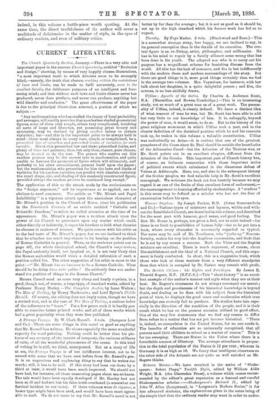CURRENT LITERATUR E.
The Church Quarterly Review, January.—There is a very able and important paper in the current Church Quarterly, entitled "Evolution and Design," showing, by means of very happily chosen illustrations, "a most important truth to which Atheists seem to be strangely blind,—namely, the truth that chance, working within the restrictions of laws and limits, can be made to fulfil accurately, even to the smallest details, the deliberate purposes of an intelligent and fore- seeing mind; and that without such laws and limits chance never has produced, never does produce, and never can produce, anything but wild disorder and confusion." The great effectiveness of the paper is due to the principal illustration selected, a portion of which we subjoin :-
"Any mathematician who has studied the theory of local probability and averages, will readily perceive that numberless shaded geometrical figures, some of them very simple, others very complicated, involving all sorts of loops and branches, yet possessing great beauty and symmetry, may be devised by giving random values to certain variables ; but—and this is the important point to be always held in mind—there must always in every case, simple or complicated, be a prescribed law of variation and prescribed limits of variation for each variable. Given this prescribed law and these prescribed limits, and plenty of time and patience, then, but only then, chance, pare chance, may be trusted to do the rest. The person who carries out this random process may be the merest tyro in mathematics, and quite unable to forecast the geometrical figure which will ultimately, and probably to his utter astonishment, present itself upon the paper ; but the mathematician who prescribes for him the laws and limits of variation for his random variables, can predict with absolute certainty the exact shape, size, and shading of this randomly constructed figure, provided always the random process be continued long enough."
The application of this to the attack made by the evolutionists on the "design argument," and its importance as so applied, are too obvious to need comment. The article on " Mr. Mivart and Papal Infallibility " is a vigorous attack upon the anomalous character of Mr. Mivart's position in the Church of Rome, since his publication in the Nineteenth Century of an article entitled " Catholic and Scientific Freedom," to which we called attention at the time of its appearance. Mr. Mivart's paper was a reckless attack upon the power of his Church to pronounce upon any matter which could, either directly or indirectly, hamper his freedom to hold what theories he chooses in matters of science. We quite concur with his critic as to the bad taste of Mr. Mivart's paper, but we are inclined to think that he attaches too much importance to its bearing on the position of Roman Catholics in general. When, as the reviewer points oat on page 407, the whole theological school, the Church's magisterium, the Papal authority itself, are laughed at, it is not very likely that the Roman authorities would think a detailed refutation of such a position called for. The other suggestion of his critic is more to the point :—" Mr. Mivart has no business to be a Roman Catholic. What should he be doing dans cette galore ? He evidently does not under- stand the position of things in the Roman Church."
Messrs. Cassell send us some very cheap and handy reprints, in a good, though not, of course, a large type, of standard works, edited by Professor Henry Morley.—The Complete Angler, by Isaac Walton ; The /fan of Feeling, by Henry Mackenzie; and Lord Byron's Childe Harold. Of course, the editing does not imply notes, though we have a revised text, and in the case of The Man of Feeling, a curious index of the references to " tears." For a few pence each it is hardly pos- sible to conceive better printed works, and all of them works which had a great popularity when they were first published.


































 Previous page
Previous page